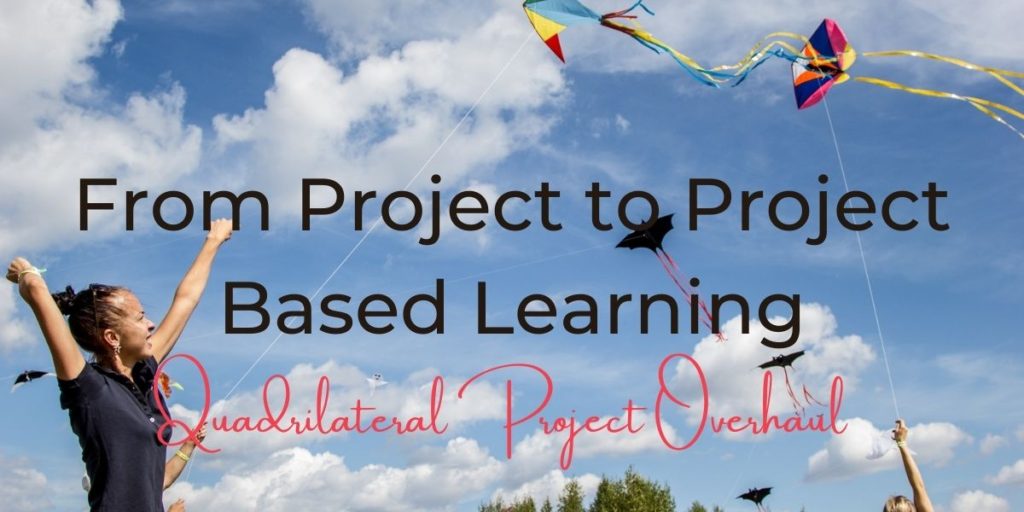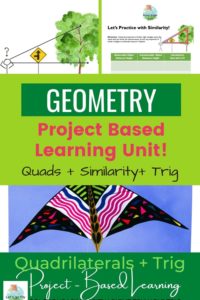The quadrilateral project is a quintessential project in geometry. One quick look at Pinterest and you’ll see plenty of examples of quadrilateral projects ranging from family trees to city design. And while there’s nothing wrong with these projects, they aren’t the kind of quadrilateral project that will develop critical thinking skills for the high school student. So how could we make them better?
From Quadrilateral Project to Project-Based Learning
The key difference between “doing projects” and project-based learning (PBL) is that in PBL the learning is uncovered as part of the inquiry process throughout the project. On the other hand, “doing projects” typically happens at the end of the learning, with limited or no inquiry involved. Let’s take that idea of the quadrilateral family tree project and turn it into a project-based learning experience.
At the heart of the quadrilateral family tree project is understanding the quadrilateral properties. Students should think critically about which quadrilaterals belong together and their relationship to one another. So, how else could we get them thinking of the properties of quadrilaterals? And furthermore, why should the students care about the properties of quadrilaterals?’

High School Quadrilateral Project Based Learning Ideas
Project based learning needs to be real and relevant for our students. When I first designed a kite project nearly ten years ago, I did so because our local community hosted a kite festival each year. My students knew that the kites they were designing would have the ability to fly at the kite festival. This made the need and desire to understand quadrilaterals that much more enticing. If you don’t have a kite festival nearby, you could make this ideal real and relevant to your students by:
- Hosting your own Kite Festival
- Learning about the global culture of kite flying as a sport/activity in other countries.
- Teaming up with a younger grade level and creating kites for those students
Another key to project based learning? It often doesn’t isolate skills. As you will see, this is a polygon and quadrilateral project. Students are thinking critically about the features of all of the polygons, not just the quadrilaterals in this project. Inside, there is also an opportunity for students to focus on triangles through right triangle similarity or even trigonometry. Learning these concepts in isolation removes the relevance of the content. Learning them in tandem shows cohesion. This enables students to develop key reasoning and critical thinking about geometric figures that they can then apply outside the classroom.
Enough already… what is this project?
Let’s Go Fly a Kite is an all-encompassing plug + play project-based learning unit designed to get your students exploring quadrilaterals, similarity and trigonometry through designing and flying our own custom kites! (Remember these units are designed to work with any standard mathematics curriculum–letting you PLUG in your Curriculum (direct instruction + practice) as needed to meet your needs!)
- In Milestone 1– Kite Analysis, students get familiar with the most popular kite designs. Students analyze designs to determine 2D figures that model the kites, as well as any and all symmetry within the design!
- In Milestone 2– A kite of Many Names: Polygon Comparison, students investigate the key features of design for kites. They then design, create, test and analyze three of their own designs!
- In Milestone 3 + 3 Extension– High Fliers (with or without Trig!) students create their own clinometers. Using either right triangle similarity or right triangle trigonometry, they practice indirectly measuring. Then they use them to measure how high their kite can fly!
- In Milestone 4– The Best Kite- students synthesize their learning from the project as they create a final product to communicate why their kite is the best, and back it up with mathematical reasoning and justification! Single point rubric included!
Not quite ready for a full scale project?
Love the idea but not sure you can swing a full project-based learning unit on it this year? No problem, I’ve got you covered.
I created an end of unit quadrilateral project on Kite Design that incorporates many of the same skills listed above.
What other quadrilateral project ideas can you think of?
Keep it real,


Ready to design your own projects? Join us for PBL for Math Teachers BootCamp!









